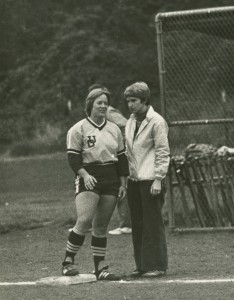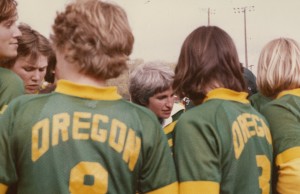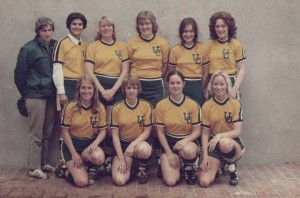UO Women’s Softball — Part I: Becky Sisley and Women’s Athletics

UO Special Collections and University Archives, in collaboration with Oregon Softball and the Women In Flight program, presents a three-part series this week detailing the early history of Oregon women’s softball in celebration of the last regular season games this weekend at Howe Field (1936-2015). Part I focuses on the career of Becky Sisley, former women’s athletic director at the University of Oregon, and her contributions to the growth of women’s athletics on campus; Wednesday’s post will feature a look at the rise of softball in the 1970s in the wake of Title IX legislation; and Thursday’s post will detail the development of UO’s first dedicated softball field in 1979.
Becky Sisley was the driving force behind the development and expansion of women’s varsity sports programs at the University of Oregon. Born on May 10, 1939 in Seattle, Sisley graduated with a B.A. in Physical Education from the University of Washington in 1961. After finishing her undergraduate degree, Sisley worked as a P.E. teacher at Lake Washington High School in Kirkland during the 1961-1962 school year before moving across the country. The next year, Sisley earned her M.S. in Physical Education at the University of North Carolina at Greensboro while also working as a graduate teaching assistant.
After earning her Master’s degree, Sisley spent two years as a physical education instructor at the University of Wisconsin in Madison. In 1965, she returned to the Pacific Northwest to take a position in the Department of Women’s Physical Education at the University of Oregon. In this era no women came to the university with coaching experience. That first year she served as advisor for intramural basketball, the Basketball Interest Group, and the Softball Interest Group.
She assumed the role of field hockey coach in 1967 after the retirement of professor Janet Woodruff. Sisley had played intercollegiate field hockey at the University of Washington, as it was the one sport in the northwest where women were coached in the 1940s and 1950s. But softball was Sisley’s main sport as she had extensive experience in the game, having played since 1955 on Amateur Softball Association (ASA) teams in Seattle and Portland. As a member of the Erv Lind Portland team , Sisley was an outfielder on the 1964 World Softball Championship-winning squad.

Sisley would also serve as the advisor for the Women’s Recreation Association (WRA) during her first few years on campus, which sponsored women’s intramural and extramural athletic opportunities. The Women’s Sports Council, a student advisory body, was formed under the direction of Sisley in 1968. After being granted tenure within the newly-combined Physical Education department in 1971, Sisley took a year sabbatical in 1971-1972; during this period she returned to UNC-Greensboro, where she completed work toward her doctorate with an emphasis on administration and coaching. After her dissertation defense in September 1972, Sisley formally graduated with her doctorate in 1973.
After an extensive review of the growth of women’s athletic throughout the country at the collegiate level, President Robert Clark authorized the creation of Women’s Intercollegiate Athletics (WIA) as a unit within the Physical Education department. Sisley had been at the forefront of this movement, having served as a member of the Division for Girls’ and Women’s National Executive Board from 1968 to 1970, as a commissioner for Intercollegiate athletics from 1970 to 1972, and as a member of the first Executive Board for the Association for Intercollegiate Athletics for Women. (The AIAW was the national governing body for women’s intercollegiate athletics from 1971 to 1981.) Thus Sisley was the logical person to be named Oregon’s WIA Director beginning in the fall of 1973.

In that role Sisley would fight to insure Oregon met compliance with Title IX regulations. Her efforts would lead to a significant increase in funding for women’s sports, as the budget grew from $40,000 to $424,000 during her six years in the position. On April 1, 1977, the WIA was combined with Department of Intercollegiate Athletics to form a single athletic department at the university; two years later, Sisley announced that she would resign her position as women’s athletic director as it was too demanding to serve as a head coach and athletic director concurrently.
“I had to start from scratch when I accepted the position of women’s athletic director,” Sisley told the Register-Guard in 1979 upon the announcement of her resignation from the role. “I couldn’t look to see what the person before me had done, because it had never been done before. I think we’ve got an excellent base at the University of Oregon, and we have developed a good reputation across the nation. In other words, it seemed like a good time for me to redirect some of my own professional interests.”
Though Sisley did not resume coaching duties upon her return from 1979-1980 sabbatical, she maintained her influence on the advancement of women’s sport. She taught in the Department of Physical Education and Human Movement Studies where she created the coaching minor and served as Director of Undergraduate Studies. In 1987 she created the Oregon Women’s Sports Leadership Network which sponsored a program to mentor women to become high school athletic directors. The network still conducts educational seminars for women in sports leadership positions.

During the 1991-1992 academic year Sisley served in the Office of Academic Advising and Student Services, where she oversaw the closure of the physical education program due to Measure 5 budget cuts. She joined the new Physical Activity and Recreation Services Department in 1992 and formally retired in 2000 as a professor emeritus.
In 1989, the same year she was granted full professorship after an appeal, Sisley began to compete in track and field events at the national level. After taking up the pole vault in 1994 she became the best pole vaulter in her age group, setting world records at the 55-59 year old, 60-64 year old, and 65-69 year old levels. Nearly every year she won all of the events she competed in at National Championships and set javelin records annually. At age 70 she broke the world heptathlon record, and again the pole vault record while earning seven medals at the World Championships. Not merely intent on being a coach for others, Sisley continued to illustrate by example what commitment could accomplish in the athletic realm. She was inducted into the USA Track and Field Masters Hall of Fame in 2001.
In 1998, Sisley was inducted into the University of Oregon Hall of Fame for her decades of contributions to women’s athletics at the university. Two years later, the athletic department created the Becky L. Sisley Award in her honor to recognize former female athletes at the school for their professional achievements, community service, and support for their alma mater.
Information for this article was collected from the following sources:
- “AD official to quit after end of season,” Daily Emerald (Eugene), April 6, 1979, 12.
- “Becky Sisley has been major athletic influence,” Oregon Sports (Eugene), May 4, 1979, 2.
- “Becky Sisley: Woman of Willpower,” Leadership and Legacy: Athletics at the University of Oregon, accessed April 15, 2015, http://sportshistory.uoregon.edu/topics/the-universitys-response-to-title-ix/leading-advocates/becky-sisley/.
- Cathy Henkel, “Women’s athletic director at Oregon resigns position,” Register-Guard (Eugene), April 5, 1979, 4D, https://news.google.com/newspapers?nid=1310&dat=19790405&id=0hVWAAAAIBAJ&sjid=_eEDAAAAIBAJ&pg=5280,1679400&hl=en.
- “Sisley, Becky L. – Physical Education,” University Archives biographical single files, UA Ref 7, Box 9, Special Collections & University Archives, University of Oregon Libraries, Eugene, Oregon.
- This post has been periodically edited thanks to additional insights from Becky Sisley.
Zach Bigalke
Student Research Assistant

